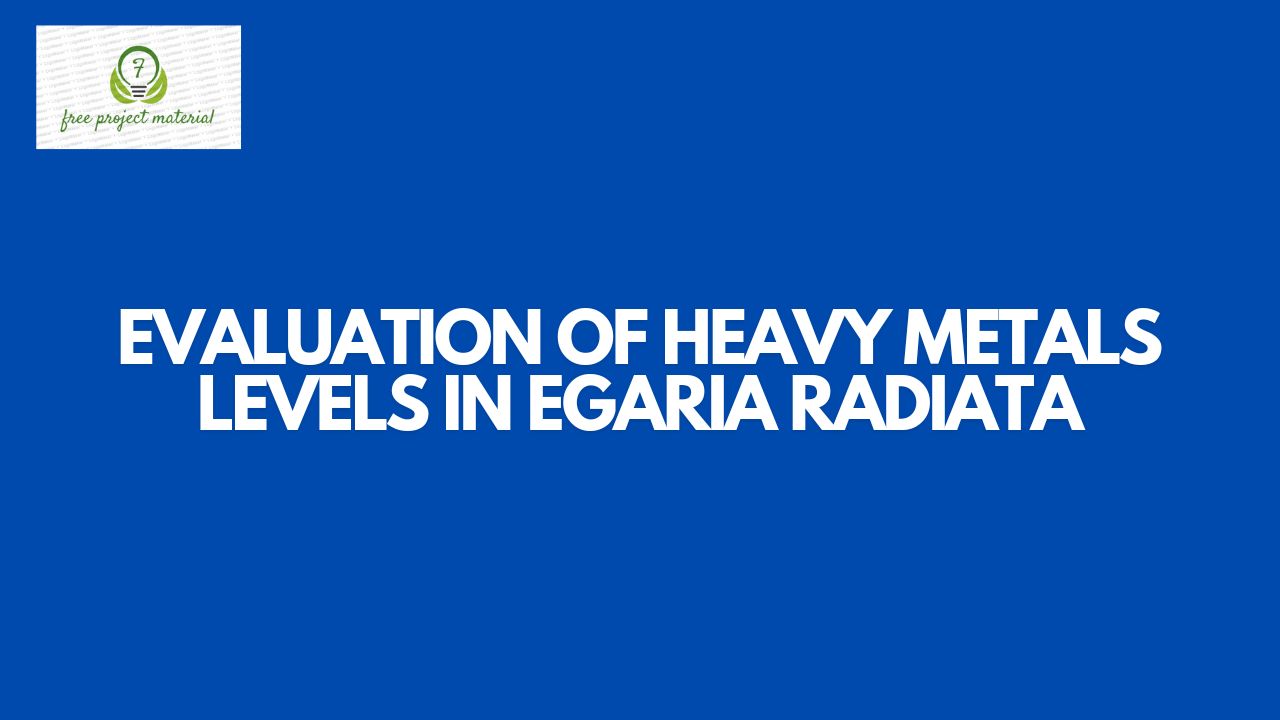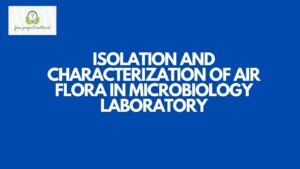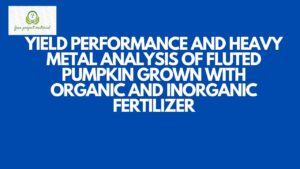ABSTRACT
In Itam market, activities of food stuff handlers and vendors are not of recommendable standard. And some of the food stuff could have been harvested from pollution laden environment using digestion process of heavy metal analysis on the flesh of Egaria radiata bought from the Itam Market, Zn (4.72 mg/kg). Cd (0.84 mg/kg) and Fe (5.74 mg/kg) were higher in concentration. High concentration of Cd can cause renal disfunction and obstructive lung disease. High concentration of Fe, Zn and Copper stems from the fact that non-vertebrate fauna species have affinity for their intake intake due to role these elements play in their metabolism processes. Although cadmium value was higher than the WHO maximum permissible limit, the level could be described as being tolerance. Egaria radiata from Itam market is safe for both human and animals consumptions because the contamination level is not alarming, heavy metal wise.
TABLE OF CONTENTS
Title Page – – – – – – – – – i
Certification – – – – – – – – ii
Dedication – – – – – – – – – iii
Acknowledgments – – – – – – – iv-v
Abstracts – – – – – – – – – vi
Table of Contents – – – – – – – – vii-ix
CHAPTER ONE: INTRODUCTION
1.1 Background of the Study – – – – – – 1-2
1.2 Aim of the Study – – – – – – – 2
1.3 Objective of the Study – – – – – – 2
1.4 Scope of the Study – – – – – – – 3
1.5 Limitation of the Study – – – – – – 3
1.6 Significance of the Study – – – – – 3
1.7 Definition of Terms – – – – – – 3-4
CHAPTER TWO: LITERATURE REVIEW
2.1 Biology of Egaria radiata – – – – – 5
2.1.1 Morphology – – – – – – – 5
2.1.2 Life Cycle – – – – – – – – 6
2.1.3 Feeding Habit – – – – – – – 7-9
2.1.4 Locomotion – – – – – – – – 9-10
2.1.5 Biology Importance of Shell – – – – – 10-12
2.1.6 Biology Importance of Flesh – – – – – 12-14
2.1.7 Social Habit – – – – – – – 15
2.2 Heavy Metal – – – – – – – 16
2.2.1 Copper (Cu) – – – – – – – – 16-19
2.2.2 Zinc (Zn) – – – – – – – – 19-23
2.2.3 Cadmium (Cd) – – – – – – – 23-25
2.2.4 Iron (Fe) – – – – – – – – 25-26
2.2.4 Cobalt (Co) – – – – – – – 26-27
CHAPTER THREE: MATERIALS AND METHODS
3.1 Material Used – – – – – – – 28
3.2 Methods – – – – – – – – 28
3.2.1 Study Area – – – – – – – – 28
3.2.2 Sample Collection – – – – – – – 30
3.2.3 Analysis – – – – – – – – 30
CHAPTER FOUR: RESULT AND CONCLUSION
4.1 Results – – – – – – – – 31
4.2 Discussion – – – – – – – – 32
4.2.1 Cadmium (Cd) – – – – – – – 32
4.2.2 Cobalt (Co) – – – – – – – – 32-33
4.2.3 Iron (Fe) – – – – – – – – 33
4.2.4 Copper (Cu) – – – – – – – – 33-34
4.2.5 Zinc (Zn) – – – – – – – – 34-35
CHAPTER FIVE: CONCLUSION AND RECOMMENDATIONS
5.1 Conclusion – – – – – – – – 36-37
5.2 Recommendations – – – – – – – 37
REFERENCES
CHAPTER ONE: INTRODUCTION
1.1 Background of the Study
Egaria radiata, which is commonly referred to as the West Africa clam are lean source of protein, rich in minerals, vitamins and omega-3 fatty acid. They promote sexual health and have been found to possess cancer preventing properties (Michael, 2019). But the consumption of these organisms is threatened by heavy metals introduced along with other wastes even micronutrient which are essential in trace contaminate for maintenance of living organisms. However, at higher concentration such heavy metals can lead to poisoning.
Sources of these pollutants into the environment include both anthropogenic and natural activities, and industrial process has become one of the topical issues facing communities today (Odemelan et al., 2020). Increased level of urbanization and industrialization, coupled with population explosion heightened introduction of contaminants into aquatic bodies, causing injuries to the environment through food chain. Some of these pollutants can bio-accumulate when transferred along the food chain (Osu and Odoemelan, 2015), creating toxicity if not controlled. They also affect properties of water including organoleptic, physic-chemical properties etc.
Itam market, like any other market in Akwa Ibom State, might become a centre for contaminated gastropods like E. radiata because the aquatic environment where they are harvested from might be heavy metal contamination laden. Also food handlers and poor hygienic method of handling food might promote contamination. This work is tailored towards verifying how contamination laden, heavy metal wise, gastropods sold in the Itam Market are, and also to proffer recommendation on the way forward.
1.2 Aims of the Study
To determine the contamination status of heavy metals in gastropods using E. radiata from Itam Market.
1.3 Objectives of the Study
- To analyzed for Zn, Cu, Fe, Cd and Co in flesh of Egaria radiata.
- To compare the result obtained with WHO permissible range.
- To ascertain the safety/contamination level of E. radiata from Itam Market.
1.4 Scope of the Study
This work covers only one species of gastropods, Egaria radiata, from one study area (Itam Market).
1.5 Limitations
- Financial constraints
- Lack of time
1.6 Significance of the Study
This work will add to already existing facts on food contamination especially on Itam Market.
1.7 Definition
Anthropogenic Activities
The anthropogenic activities are human activities such as mining, release of industrial waste, smelting of Arsenic ore, incineration of fossil fuel, particularly coal, utilization of Arsenic-loaded water for irrigation, and Arsenic-based pesticides, herbicides and fertilizers (Karimi et al., 2009).
Digestion: This is the breakdown of large insoluble food molecules into small water soluble food molecules so that they can be absorbed into the watery blood plasma. It is also the breaking down of complex substances to obtain the simpler ones.
Bio accumulative: This is the gradual accumulation of substances, such as pesticides or other chemicals, in an organism.
Biomagnification: This is the process by which a compound (such as a pollutant or pesticide) increases its concentration in the issues of organisms as it travels up the food chain.
Heavy Metals: This is defined as metals with relative high densities, atomic weights or atomic numbers.
Food Chain: This is the sequence of transfers of matter and energy in the form of food from organism to organism.


